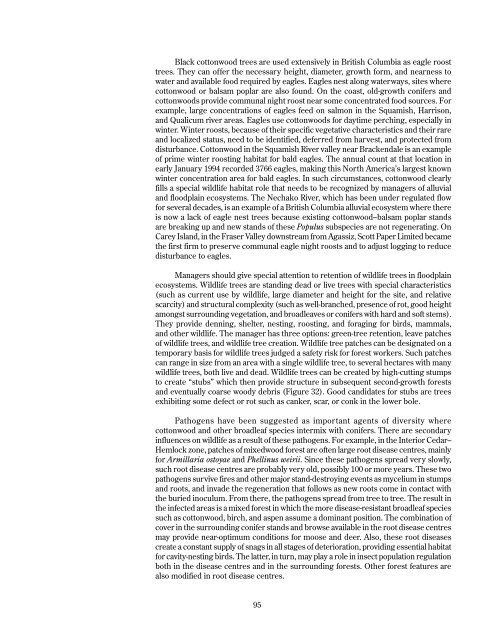FRDA Report: Black Cottonwood and Balsam Poplar Managers ...
FRDA Report: Black Cottonwood and Balsam Poplar Managers ...
FRDA Report: Black Cottonwood and Balsam Poplar Managers ...
You also want an ePaper? Increase the reach of your titles
YUMPU automatically turns print PDFs into web optimized ePapers that Google loves.
<strong>Black</strong> cottonwood trees are used extensively in British Columbia as eagle roost<br />
trees. They can offer the necessary height, diameter, growth form, <strong>and</strong> nearness to<br />
water <strong>and</strong> available food required by eagles. Eagles nest along waterways, sites where<br />
cottonwood or balsam poplar are also found. On the coast, old-growth conifers <strong>and</strong><br />
cottonwoods provide communal night roost near some concentrated food sources. For<br />
example, large concentrations of eagles feed on salmon in the Squamish, Harrison,<br />
<strong>and</strong> Qualicum river areas. Eagles use cottonwoods for daytime perching, especially in<br />
winter. Winter roosts, because of their specific vegetative characteristics <strong>and</strong> their rare<br />
<strong>and</strong> localized status, need to be identified, deferred from harvest, <strong>and</strong> protected from<br />
disturbance. <strong>Cottonwood</strong> in the Squamish River valley near Brackendale is an example<br />
of prime winter roosting habitat for bald eagles. The annual count at that location in<br />
early January 1994 recorded 3766 eagles, making this North America’s largest known<br />
winter concentration area for bald eagles. In such circumstances, cottonwood clearly<br />
fills a special wildlife habitat role that needs to be recognized by managers of alluvial<br />
<strong>and</strong> floodplain ecosystems. The Nechako River, which has been under regulated flow<br />
for several decades, is an example of a British Columbia alluvial ecosystem where there<br />
is now a lack of eagle nest trees because existing cottonwood–balsam poplar st<strong>and</strong>s<br />
are breaking up <strong>and</strong> new st<strong>and</strong>s of these Populus subspecies are not regenerating. On<br />
Carey Isl<strong>and</strong>, in the Fraser Valley downstream from Agassiz, Scott Paper Limited became<br />
the first firm to preserve communal eagle night roosts <strong>and</strong> to adjust logging to reduce<br />
disturbance to eagles.<br />
<strong>Managers</strong> should give special attention to retention of wildlife trees in floodplain<br />
ecosystems. Wildlife trees are st<strong>and</strong>ing dead or live trees with special characteristics<br />
(such as current use by wildlife, large diameter <strong>and</strong> height for the site, <strong>and</strong> relative<br />
scarcity) <strong>and</strong> structural complexity (such as well-branched, presence of rot, good height<br />
amongst surrounding vegetation, <strong>and</strong> broadleaves or conifers with hard <strong>and</strong> soft stems).<br />
They provide denning, shelter, nesting, roosting, <strong>and</strong> foraging for birds, mammals,<br />
<strong>and</strong> other wildlife. The manager has three options: green-tree retention, leave patches<br />
of wildlife trees, <strong>and</strong> wildlife tree creation. Wildlife tree patches can be designated on a<br />
temporary basis for wildlife trees judged a safety risk for forest workers. Such patches<br />
can range in size from an area with a single wildlife tree, to several hectares with many<br />
wildlife trees, both live <strong>and</strong> dead. Wildlife trees can be created by high-cutting stumps<br />
to create “stubs” which then provide structure in subsequent second-growth forests<br />
<strong>and</strong> eventually coarse woody debris (Figure 32). Good c<strong>and</strong>idates for stubs are trees<br />
exhibiting some defect or rot such as canker, scar, or conk in the lower bole.<br />
Pathogens have been suggested as important agents of diversity where<br />
cottonwood <strong>and</strong> other broadleaf species intermix with conifers. There are secondary<br />
influences on wildlife as a result of these pathogens. For example, in the Interior Cedar–<br />
Hemlock zone, patches of mixedwood forest are often large root disease centres, mainly<br />
for Armillaria ostoyae <strong>and</strong> Phellinus weirii. Since these pathogens spread very slowly,<br />
such root disease centres are probably very old, possibly 100 or more years. These two<br />
pathogens survive fires <strong>and</strong> other major st<strong>and</strong>-destroying events as mycelium in stumps<br />
<strong>and</strong> roots, <strong>and</strong> invade the regeneration that follows as new roots come in contact with<br />
the buried inoculum. From there, the pathogens spread from tree to tree. The result in<br />
the infected areas is a mixed forest in which the more disease-resistant broadleaf species<br />
such as cottonwood, birch, <strong>and</strong> aspen assume a dominant position. The combination of<br />
cover in the surrounding conifer st<strong>and</strong>s <strong>and</strong> browse available in the root disease centres<br />
may provide near-optimum conditions for moose <strong>and</strong> deer. Also, these root diseases<br />
create a constant supply of snags in all stages of deterioration, providing essential habitat<br />
for cavity-nesting birds. The latter, in turn, may play a role in insect population regulation<br />
both in the disease centres <strong>and</strong> in the surrounding forests. Other forest features are<br />
also modified in root disease centres.<br />
95

















